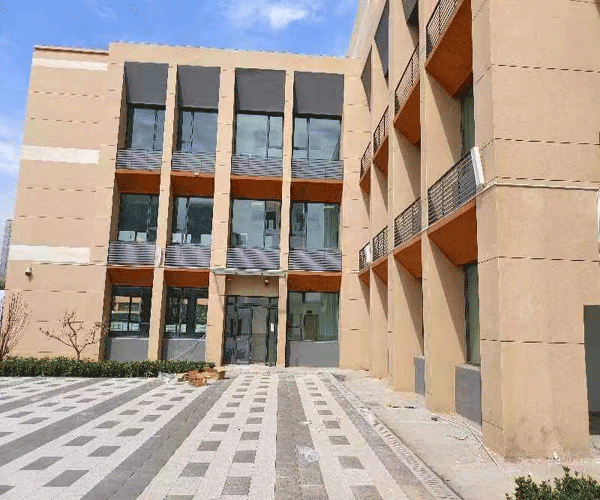- Time:2023/9/19 Posted:Guangzhou KOBOE Electronic Technology Co.,LTD.
Project Overview:
The network broadcasting system of Baiyue Shijia Primary School in Minle Road, Qilihe District, Lanzhou City, Gansu Province needs to achieve functions such as free grouping, broadcasting, and on-demand in each floor of the teaching building's classrooms, while also meeting the need for listening exams to be individually multicast and broadcasted on each floor. To strengthen the later construction, the system needs to consider easy expansion and upgrading in the later stage. The system consists of 18 pairs of IP network point-to-point speakers to form classroom partitions, 30 high-quality ceiling mounted indoor corridor partitions, and 5 outdoor luxury sound columns to form outdoor partitions. The system can achieve full coverage of campus classrooms, indoor and outdoor playback, paging speech, and other functions.
Project requirements:
The design of the public broadcasting system is mainly aimed at improving modern management, diversifying campus education, disseminating teaching information, and providing safe and stable listening system support for the school's examination system. The specific requirements are as follows:
Having both decentralized and centralized management modes, decentralized refers to setting up network audio terminals in each classroom of the school, which can enable independent broadcasting and control in each classroom; Centralized broadcasting refers to the establishment of system servers and sub control stations at the school's main broadcasting station. By utilizing the school network, various regional broadcasting audio terminals, network paging stations, and sub control software operating systems are connected to form a digital network broadcasting system for unified management;
Equipped with functions such as manual broadcasting, scheduled broadcasting, temporary insertion, terminal configuration, terminal status viewing, terminal work monitoring, and program library establishment, as well as supporting external functions such as fire linkage broadcasting and wireless remote control broadcasting; The system supports terminal remote on-demand, paging terminal, and broadcasting functions;
Campus education is diversified, and various self-made voice teaching audio courseware can also be uploaded to the server, automatically played on time or available for on-demand in the classroom, meeting the needs of modern school multimedia teaching. Teachers can submit scheduled playback tasks through workstation software, arrange voice playback plans and teaching materials for areas within their authority, and create a good learning atmosphere.
The principal and director do not need to go to the computer room, but can publish broadcasting management information about the school in their own offices;
School broadcasting should have the ability to achieve independent or group playback in different regions and multiple regions, which can be easily completed through software operation;
School broadcasting should have functions such as timed task software programming, system server automatic operation, playing different programs at different time periods, program automatic playback, and automatic stop to meet the automatic operation requirements of the school's unmanned system;
Listening system: The daily teaching listening system, as well as the requirements for the middle and high school entrance examination listening system.System Introduction:
According to the usage requirements of the school's broadcasting system and the distribution of the school's buildings, the broadcasting system adopts an IP network broadcasting system based on campus network mode for transmission and control. The network broadcasting system solves the problem of large and wide areas in the school, making broadcasting transmission difficult. Through the transmission of campus network, the above problems are well solved and the audio quality of campus broadcasting is guaranteed. Stable and reliable network broadcasting directly depends on the sound performance of the combination of network server and network adapter software and hardware.
The IP network broadcasting system is composed of an IP network broadcasting control center, IP network adapter, audio workstation, etc. The system server adopts high-speed dual CPU processing (32-bit MCU+16-bit DSP), digital power amplifier, short latency (0.1s), good sound quality (20-16KHZ), supports data network transmission in various audio formats (MP3, MP2, AAC, WAV), and has perfect network adaptability. At the same time, it supports real-time encoding of audio source input. The system has functions such as automatic IP address acquisition (DHCP), direct cross gateway and core routing switch Support internet broadcasting, network traffic adaptive function, and system upgrade can achieve fire linkage and network power supply (POE) function. Its efficient and stable operating system meets the requirements of building an information-based, networked, and digital campus broadcasting system in modern campuses; Simply connect to the IP network adapter in the area covered by the campus network to manage the broadcast area:
The digital IP network broadcasting system adopts TCP/IP network technology, which is widely used in the world today, to transmit audio signals in the form of IP packet protocol on local and wide area networks, completely solving the problems of poor audio quality, complex maintenance and management, and poor interactive performance in traditional broadcasting systems. The system equipment is simple to use and easy to install and expand - just connect the digital broadcasting terminal to the computer network to form a powerful digital broadcasting system.
Functional aspect: It can independently control each terminal to play different sounds. Not only can it fully realize the basic functions of traditional broadcasting systems, such as timed ringing and zoning playback, but it also has functions such as audio free on-demand and teacher arranged program playback;
In terms of transmission: The audio transmission distance is infinitely extended, making it easy to achieve campus broadcasting and leadership off campus remote broadcasting. Even when far away from abroad, the sound can be clear and smooth, just like listening to it in person. Beyond the reach of traditional analog broadcasting systems, it has absolute advantages;
In terms of sound quality: reaching stereo and CD level, suitable for daily foreign language listening training in the classroom, with each pronunciation clearly distinguishable. Especially when applied in the middle school entrance examination, college entrance examination, and college CET-4 and CET-6 listening playback, it can effectively improve students' listening scores and no longer be troubled by unclear sounds;On site images:



